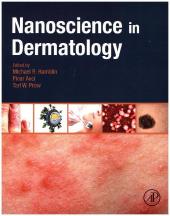 Neuerscheinungen 2016Stand: 2020-02-01 |
Schnellsuche
ISBN/Stichwort/Autor
|
Herderstraße 10
10625 Berlin
Tel.: 030 315 714 16
Fax 030 315 714 14
info@buchspektrum.de |

Pinar Avci, Michael R. Hamblin, Tarl Prow
(Beteiligte)
Nanoscience in Dermatology
Herausgegeben von Hamblin, Michael R.; Avci, Pinar; Prow, Tarl
2016. 402 S. 229 mm
Verlag/Jahr: ACADEMIC PRESS 2016
ISBN: 0-12-802926-9 (0128029269)
Neue ISBN: 978-0-12-802926-8 (9780128029268)
Preis und Lieferzeit: Bitte klicken
Nanoscience in Dermatology covers one of the two fastest growing areas within dermatological science, nanoscience and nanotechnology in dermatology. Recently, great progress has been made in the research and development of nanotechnologies and nanomaterials related to various applications in medicine and, in general, the life sciences. There is increasing enthusiasm for nanotechnology applications in dermatology (drug delivery, diagnostics, therapeutics, imaging, sensors, etc.) for understanding skin biology, improving early detection and treatment of skin diseases, and in the design and optimization of cosmetics.
Light sensitive nanoparticles have recently been explored, opening a new era for the combined applications of light with nanotechnology, also called photonanodermatology. However, concerns have been raised regarding the adverse effects of intentional and unintentional nanoparticle exposure and their toxicity.
Written by experts working in these exciting fields, this book extensively covers nanotechnology applications, together with the fundamentals and toxicity aspects. It not only addresses current applications of nanotechnology, but also discusses future trends of these ever-growing and rapidly changing fields, providing scientists and dermatologists with a clear understanding of the advantages and challenges of nanotechnology in skin medicine.
Provides knowledge of current and future applications of nanoscience and nanotechnology in dermatology
Outlines the fundamentals, methods, toxicity aspects, and other relevant aspects for nanotechnology based applications in dermatology
Coherently structured book written by experts working in the fields covered
Hamblin, Michael R.
Michael R Hamblin Ph.D. is a Principal Investigator at the Wellman Center for Photomedicine at Massachusetts General Hospital, an Associate Professor of Dermatology at Harvard Medical School and is a member of the affiliated faculty of the Harvard-MIT Division of Health Science and Technology. He was trained as a synthetic organic chemist and received his PhD from Trent University in England. His research interests lie in the areas of photodynamic therapy (PDT) for infections, cancer, and heart disease and in low-level light therapy (LLLT) for wound healing, arthritis, traumatic brain injury and hair-regrowth. He directs a laboratory of around a sixteen post-doctoral fellows, visiting scientists and graduate students. His research program is supported by NIH, CDMRP, USAFOSR and CIMIT among other funding agencies. He has published 252 peer-reviewed articles, over 150 conference proceedings, book chapters and International abstracts and holds 8 patents. He is Associate Editor for 7 journals, on the editorial board of a further 12 journals and serves on NIH Study Sections. For the past 9 years Dr Hamblin has chaired an annual conference at SPIE Photonics West entitled "Mechanisms for low level light therapy" and he has edited the 9 proceedings volumes together with four other major textbooks on PDT and photomedicine. He has several other book projects in progress at various stages of completion. In 2011 Dr Hamblin was honored by election as a Fellow of SPIE.
Avci, Pinar
Pinar Avci, MD is a Research Fellow in Wellman Center for Photomedicine, Massachusetts General Hospital and Harvard Medical School Department of Dermatology, Boston USA. She received her MD degree in General Medicine from Semmelweis University, and is currently pursuing her PhD in Department of Dermatology, Venereology and Dermato-oncology, Semmelweis University, Budapest, Hungary. She is currently conducting research in the area of Photodynamic therapy (PDT) - a localized approach for treatment of cancer and infections and its effects in developing anti-tumor immunity.
Prow, Tarl
In 2004, Dr Prow earned his Ph.D. from the University of Texas in the field of Nanomedicine. He then completed his T32 funded post-doc at the Wilmer Eye Institute at The Johns Hopkins Hospital and was faculty there until he relocated to the University of Queensland in Brisbane, Australia in 2007. In 2011 Dr Prow became the Deputy Director of the Dermatology Research Centre. In 2015, Dr Prow was promoted to Associate Professor within the University of Queensland´s School of Medicine. He leads a NHMRC and ARC funded team that focuses on drug delivery, diagnostics and imaging in the context of dermatology.


